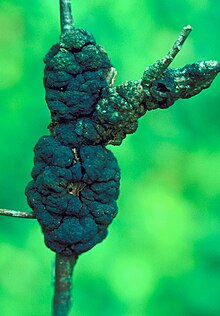Dibotryon morbosum
| Dibotryon morbosum | |
|---|---|
 |
|
| Black Knot on Cherry | |
| Scientific classification | |
| Kingdom: | Fungi |
| Phylum: | Ascomycota |
| Subdivision: | Pezizomycotina |
| Class: | Dothideomycetes |
| Order: | Pleosporales |
| Family: | Venturiaceae |
| Genus: | Dibotryon |
| Species: | D. morbosum |
| Binomial name | |
|
Dibotryon morbosum (Schwein.) Theiss. & Syd., 1915 |
|
| Synonyms | |
Dibotryon morbosum or Apiosporina morbosa is a plant pathogen, which is the causal agent of black knot. It affects cherry, plum, apricot and chokecherry trees in North America. The disease produces rough, black growths that encircle and kill the infested parts, and provide habitat for insects.
The disease was first described in 1821 in Pennsylvania, but has spread across North America. While it was one of the most destructive diseases of plum and cherry trees in the late 19th century, today it is relatively well controlled in many cultivated areas and seen primarily in poorly managed orchards, or where strongly established, including in the wild.
Black Knot occurs only on the woody parts of trees, primarily on twigs and branches, but can spread to larger limbs and even the trunk. Olive-green swellings from the disease are visible in the late spring; as it spreads and matures, typically by autumn, rough black knots circle and kill affected parts. The knots vary in diameter from one inch to one foot (2.5 cm - 30 cm). Older knots can kill trees by promoting insect infestations.
The most common treatments are pruning infected parts during the winter and spraying buds with a fungicide. Nearby wild plants with the disease must also be destroyed.
...
Wikipedia
